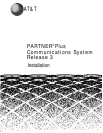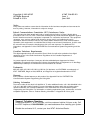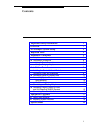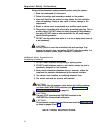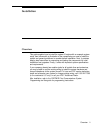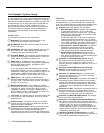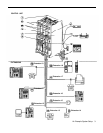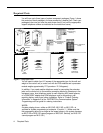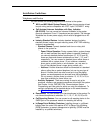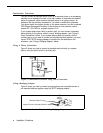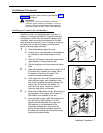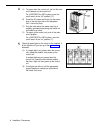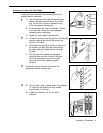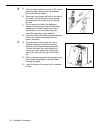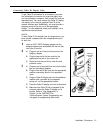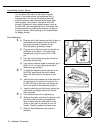
Installation Guidelines
Telephones and Devices
You can connect the following telephones and devices to the system:
MLS- and MLC-Model System Phones.
System phones require at least
■
two-pair wiring and are compatible with AT&T 4-pair SYSTIMAX™ wiring.
Call Assistant Intercom Autodialers with Busy Indication
■
(MLS-CA24).
You can connect an Intercom Autodialer to the system
phone at extensions 10 and 11 (maximum two per system). The Intercom
Autodialer has its own power supply, which must be plugged into an AC
outlet.
Industry-Standard Devices.
Industry-standard devices (including
■
standard phones) require one-pair mounting cords; AT&T D2R mounting
cords are recommended.
—
Standard Phones.
Connect standard touch-tone or rotary dial
phones to the system for:
—
Power Failure Operation.
During a power failure, system phones
will not work because they require power to operate. However, if
you connect standard phones to extensions 10, 16, 22, and 28,
users can place and answer outside calls on lines 1, 3, 5, and 7,
respectively. You can connect a standard phone either alone or
combined with a system phone. (If you combine a standard
phone and a system phone on one extension, you may want to
turn off the standard phone’s ringer during normal use.)
—
Hotlines.
A hotline extension should be connected to a standard
phone, rather than a system telephone, but can ring any type of
phone. A hotline phone can also be set up to ring the paging
system, so announcements can be made over the loudspeaker.
Do not connect a Hotline phone to extension 10, 16, 22, or 28, to
keep them available for power failure use.
—
Auxiliary Equipment.
There are a variety of ways to set up fax
machines, modems, and answering machines to work with the system.
See Chapter 4 in the PARTNER Plus Communications System
Programming and Use guide for advice on using this equipment. To
connect a telephone and a standard device on the same extension,
see “Combination Extensions” on page 6.
Doorphones.
You can connect up to two doorphones to the system. Do
■
not connect doorphones to extension 10, 11, 16, 17, 22, 23, 28, or 29.
■
Call Reporting Devices.
You can connect a call reporting device to the
SMDR jack on the processor module for recording call activity.
■
In-Range Out-of-Building Protectors.
Installing phones in a different
building from the control unit requires AT&T In-Range Out-of-Building
(IROB) protectors, to prevent damage due to lightning. (IROBS must be
installed by a qualified technician.)
Installation Guidelines
5



